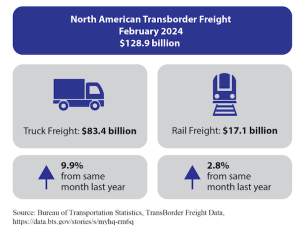Old Dominion Freight Line raises expectations for 1st quarter growth
posted by AJOT | Mar 10 2014 at 04:07 PM | Intermodal
Old Dominion Freight Line, Inc. reported an increase in its less-than-truckload ("LTL") tons per day for February 2014 of 11.7% compared with February 2013, which followed comparable-period growth of 10.1% for January 2014. Based on these results and its outlook for March, Old Dominion today raised its expectations for growth in first-quarter 2014 LTL tons per day to a range of 11.0% to 11.5% from the previously reported range of 10.0% to 11.0% over the prior-year comparable quarter. The Company also affirmed its expectations for comparable-period growth in LTL revenue per hundredweight, excluding fuel surcharges, to be in a range of 2.0% to 2.5% for the first quarter of 2014.
David S. Congdon, President and Chief Executive Officer of Old Dominion, commented, "Old Dominion has continued to produce double-digit growth in LTL tons per day in a period of weak economic growth and significant adverse weather conditions, primarily through ongoing gains in market share. We believe the combination of substantial growth in tons with sustained yield improvement demonstrates the demand for our value proposition of superior service at a fair and equitable price."
Forward-looking statements in this news release are made pursuant to the safe harbor provisions of the Private Securities Litigation Reform Act of 1995. Investors are cautioned that such forward-looking statements involve risks and uncertainties that could cause actual events and results to be materially different from those expressed or implied herein, including, but not limited to, the following: (1) the competitive environment with respect to industry capacity and pricing, including the use of fuel surcharges, such that our total overall pricing is sufficient to cover our operating expenses; (2) our ability to collect fuel surcharges and the effectiveness of those fuel surcharges in mitigating the impact of fluctuating prices for fuel and other petroleum-based products; (3) the negative impact of any unionization, or the passage of legislation or regulations that could facilitate unionization, of our employees; (4) the challenges associated with executing our growth strategy, including the inability to successfully consummate and integrate acquisitions, if any; (5) changes in our goals and strategies, which are subject to change at any time at our discretion; (6) various economic factors such as economic recessions and downturns in customers' business cycles and shipping requirements; (7) increases in driver compensation or difficulties attracting and retaining qualified drivers to meet freight demand; (8) our exposure to claims related to cargo loss and damage, property damage, personal injury, workers' compensation, group health and group dental, including increased premiums, adverse loss development, increased self-insured retention levels, and claims in excess of coverage levels; (9) cost increases associated with employee benefits, including compliance obligations associated with the Patient Protection and Affordable Care Act; (10) the availability and cost of capital for our significant ongoing cash requirements; (11) the availability and cost of replacement parts and new equipment, including regulatory changes and supply constraints that could impact the cost of these assets; (12) decreases in demand for, and the value of, used equipment; (13) the availability and cost of diesel fuel; (14) the costs and potential liabilities related to compliance with, or violations of, existing or future governmental laws and regulations, including environmental laws, engine emissions standards, hours-of-service for our drivers, driver fitness requirements and new safety standards for drivers and equipment; (15) the costs and potential liabilities related to litigation and governmental proceedings; (16) the costs and potential liabilities arising from our international business operations and relationships; (17) the costs and potential adverse impact of non-compliance with rules issued by the Federal Motor Carrier Safety Administration; (18) seasonal trends in the less-than-truckload industry, including the possibility of harsh weather conditions; (19) our dependence on key employees; (20) the concentration of our stock ownership with the Congdon family; (21) the costs and potential adverse impact associated with future changes in accounting standards or practices; (22) the impact caused by potential disruptions to our information technology systems or our service center network; (23) damage to our reputation from the misuse of social media; (24) dilution to existing shareholders caused by any issuance of additional equity; and (25) other risks and uncertainties indicated from time to time in our filings with the Securities and Exchange Commission. Our forward-looking statements are based upon our beliefs and assumptions using information available at the time the statements are made. We caution the reader not to place undue reliance on our forward-looking statements (i) as these statements are neither a prediction nor a guarantee of future events or circumstances and (ii) the assumptions, beliefs, expectations and projections about future events may differ materially from actual results. We undertake no obligation to publicly update any forward-looking statement to reflect developments occurring after the statement is made, except as otherwise required by law.







